Genesis of the Yi’nan Tongjing Gold–Copper Skarn Deposit, Luxi District, North China Craton: Evidence from Fluid Inclusions and H–O Isotopes
Abstract
:1. Introduction
2. Geological Setting
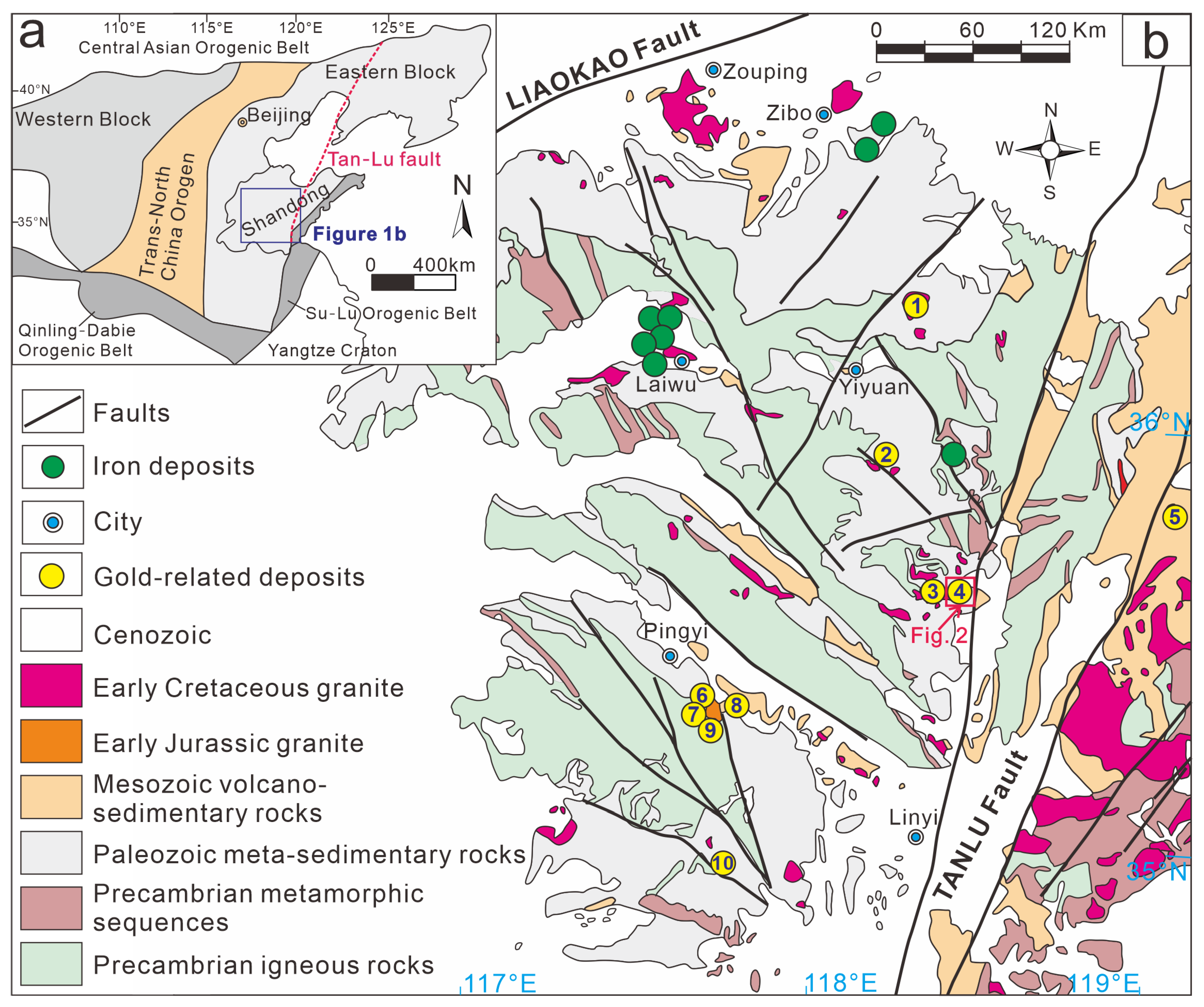
3. Deposit Geology


4. Samples and Analytical Methods
4.1. Fluid Inclusions
4.2. Hydrogen and Oxygen Isotopic Analyses
5. Results
5.1. Fluid Inclusions
5.1.1. Fluid Inclusion Petrography
5.1.2. Fluid Inclusion Microthermometry
5.2. Hydrogen and Oxygen Isotopic Analysis
6. Discussion
6.1. Fluid Nature and Depth Estimation
6.2. Source of Ore-Forming Fluids and Materials
6.3. Ore Genesis
7. Conclusions
Supplementary Materials
Author Contributions
Funding
Data Availability Statement
Conflicts of Interest
References
- Einaudi, M.T.; Meinert, L.D.; Newberry, R.J. Skarn deposits. In Economic Geology: Seventy-Fifth Anniversary Volume; Skinner, B.J., Ed.; Society of Economic Geologists: Littleton, CO, USA, 1981; pp. 317–391. [Google Scholar]
- Hedenquist, J.W.; Lowenstern, J.B. The role of magmas in the formation of hydrothermal ore deposits. Nature 1994, 370, 519–527. [Google Scholar] [CrossRef]
- Meinert, L.D.; Dippl, G.M.; Nicolescu, S. World skarn deposits. Econ. Geol. 2005, 100, 299–366. [Google Scholar]
- Chang, Z.S.; Shu, Q.H.; Meinert, L.D. Skarn deposits of China. SEG Spec. Pub. 2019, 22, 189–234. [Google Scholar]
- Cai, W.Y.; Zhang, Z.L.; Liu, X.; Gao, J.L.; Ma, M.; Li, Y.; Song, Y.X.; Li, Z.S. Metallogeny of the Yi’nan Tongjing Au–Cu skarn deposit, Luxi district, North China Craton: Perspective from in-suit trace elements, sulfur and lead isotopes of sulfides. Front. Earth Sci. 2023, 10, 1084212. [Google Scholar] [CrossRef]
- Chen, Y.J.; Chen, H.Y.; Zaw, K.; Pirajno, F.; Zhang, Z.J. Geodynamic settings and tectonic model of skarn gold deposits in China: An overview. Ore Geol. Rev. 2007, 31, 139–169. [Google Scholar] [CrossRef]
- Xie, J.C.; Zhang, X.; Huang, S.; Ge, L.K.; Li, Q.Z.; Sun, W.D. Genesis of Chaoshan skarn Au deposit, Tongling, eastern China: Insights from mineral geochemistry. J. Geochem. Explor. 2022, 241, 107055. [Google Scholar] [CrossRef]
- Chao, N.; Chen, X.; Wu, J.H.; Wang, X.Y.; Lin, Y.B.; Lin, D.C.; Li, J.B.; Gu, Y.; Li, M.; Lu, J.L.; et al. Age and compositions of garnet in a magnesian skarn Au-Cu deposit, Tibet, implications for ore-fluid evolution. Ore Geol. Rev. 2023, 152, 105248. [Google Scholar] [CrossRef]
- Gao, X.Q.; Sun, X.M.; Fu, Y.; Liu, Q.F. Garnet geochemistry of the giant Beiya gold–polymetallic deposit in SW China: Insights into fluid evolution during skarn formation. Ore Geol. Rev. 2022, 150, 105198. [Google Scholar] [CrossRef]
- Cai, W.Y.; Wang, K.Y.; Li, J.; Fu, L.J.; Li, S.D.; Yang, H.; Yassa, K. Genesis of the bagenheigeqier Pb–Zn skarn deposit in inner Mongolia, NE China: Constraints from fluid inclusions, isotope systematics and geochronology. Geol. Mag. 2021, 158, 271–294. [Google Scholar] [CrossRef]
- Xu, Y.G.; Wu, X.Y.; Luo, Z.Y.; Ma, J.L.; Huang, X.L.; Xie, L.W. Zircon Hf isotope compositions of Middle Jurassic-early Cretaceous intrusions in Shandong Province and its implications. Acta Petrol. Sin. 2007, 23, 307–316, (In Chinese with English abstract). [Google Scholar]
- Wang, Y.; Fan, H.R.; Hu, F.F.; Lan, T.G.; Jiao, P.; Wang, S.P. ZirconU-Pb ages and geoche mistry of ele ments and isotopes of the diorite from Tongjing, Yinan, Western Shandong Province. Miner. Petrol. 2011, 30, 553–566, (In Chinese with English abstract). [Google Scholar]
- Duan, Z.; Gleeson, S.A.; Gao, W.S.; Wang, F.Y.; Li, J.W. Garnet U-Pb dating of the Yinan Au-Cu skarn deposit, Luxi District, North China Craton: Implications for district-wide coeval Au-Cu and Fe skarn mineralization. Ore Geol. Rev. 2020, 118, 103310. [Google Scholar] [CrossRef]
- Qiu, J.S.; Wang, D.Z.; Ren, Q.J. Geological geochemical characteristics and Genesis of the Jinchang skarn type gold-copper deposit. Yinan City. Shandong Prov. Miner. Depos. 1996, 15, 330–340, (In Chinese with English abstract). [Google Scholar]
- Dong, S.Y. Metallogenesis, Metallogenic Laws and Metallogenic Prediction of the Yinan Gold Deposit, Shandong Province. Ph.D. Thesis, China University of Geosciencese, Wuhan, China, 2008; pp. 60–68, (In Chinese with English abstract). [Google Scholar]
- Gu, X.X.; Dong, S.Y.; Wang, Y.H.; Hu, G.Z.; Du, S.H.; Jiao, P. A new example of unconformity-related endogenic metalization: The Yinan Au-Cu-Fe deposit, Shandong Province, China. Geoscience 2008, 22, 151–161. [Google Scholar]
- Li, K.; Gu, X.X.; Dong, S.Y. Isotopic geochemistry of yinan Au-Cu-Fe deposit in shandong province. Miner. Depos. 2009, 28, 93–104, (In Chinese with English abstract). [Google Scholar]
- Wang, Y. Late Mesozoic Magmatism and Gold-Coppermineraliztion in the Southwestern Part of Shandong Province. Ph.D. Thesis, Chinese Academy of Sciences, Beijing, China, 2010; pp. 1–199. (In Chinese). [Google Scholar]
- Li, H.K.; Geng, K.; Li, Y.F.; Zhuo, C.Y. Zircon SHRIMP U-Pb age of Tongjing gold deposit in Yinan County, Shandong and its geological significance. Mineral. Depos. 2011, 30, 497–503, (In Chinese with English abstract). [Google Scholar]
- Tian, J.X.; Li, X.Z.; Song, Z.Y.; Liu, H.D.; Huang, Y.B.; Zhu, D.C. Environment formation age and material sources of mesozoic golddeposits in Western shandong a synthesis. Acta Geol. Sin. 2015, 89, 1530–1537, (In Chinese with English abstract). [Google Scholar]
- Zhu, D.C.; Tian, R.C.; Tian, J.X.; Yu, X.F.; Yang, Z.Y.; Yang, S.P. He-Ar Isotopic Determination of Skarn Type Copper Gold Deposits in Western Shandong and Its Geological Significance-Taking Tongjing Type Copper Gold Deposits in Yinan Area as an Example. Shandong Land Resour. 2018, 34, 1–5, (In Chinese with English abstract). [Google Scholar]
- Zhao, G.; Wilde, S.A.; Cawood, P.A.; Sun, M. Archean blocks and their boundaries in the North China Craton: Lithological, geochemical, structural and P-T path constraints and tectonic evolution. Precambrian Res. 2001, 107, 45–73. [Google Scholar] [CrossRef]
- Wu, F.Y.; Yang, J.H.; Liu, X.M. Geochronological Framework of the Mesozoic Granitic Magmatism in the Liaodong Peninsula, Northeast China. Geol. J. China Univ. 2005, 11, 305–317, (In Chinese with English abstract). [Google Scholar]
- Zhao, G.C.; Cawood, P.A.; Li, S.Z.; Wilde, S.A.; Sun, M.; Zhang, J.; He, Y.H.; Yin, C.Q. Amalgamation of the North China Craton: Key issues and discussion. Precambrian Res. 2012, 222–223, 55–76. [Google Scholar] [CrossRef]
- Santosh, M.; Liu, D.Y.; Shi, Y.R.; Liu, S.J. Paleoproterozoic accretionary orogenesis in the North China Craton: A SHRIMP zircon study. Precambrian Res. 2013, 227, 29–54. [Google Scholar] [CrossRef]
- Dong, Y.P.; Santosh, M. Tectonic architecture and multiple orogeny of the Qinling Orogenic Belt, Central China. Gondwana Res. 2016, 29, 1–40. [Google Scholar] [CrossRef]
- Zhao, G.C.; Sun, M.; Wilde, S.A.; Li, S.Z. Late Archean to Paleoproterozoic evolution of the North China Craton: Key issues revisited. Precambrian Res. 2005, 136, 177–202. [Google Scholar] [CrossRef]
- Xu, Y.G.; Li, H.Y.; Pang, C.J.; He, B. On the timing and duration of the destruction of the North China Craton. Chin. Sci. Bull. 2009, 54, 3379–3396. [Google Scholar] [CrossRef]
- Zhu, R.X.; Xu, Y.G.; Zhu, G.; Zhang, H.F.; Xia, Q.K.; Zheng, T.Y. Destruction of the North China Craton. Sci. China Earth Sci. 2012, 55, 1565–1587. [Google Scholar] [CrossRef]
- Zhu, R.X.; Yang, J.H.; Wu, F.Y. Timing of destruction of the North China Craton. Lithos 2012, 149, 51–60. [Google Scholar] [CrossRef]
- Liu, S.; Hu, R.Z.; Zhao, J.H.; Feng, C.X. K–Ar geochronology of Mesozoic mafic dikes in Shandong Province, Eastern China: Implications for crustal extension. Acta. Geol. Sin. 2004, 78, 1207–1213. [Google Scholar]
- Zhang, H.F. Destruction of ancient lower crust through magma underplating beneath Jiaodong Peninsula, North China Craton: U–Pb and Hf isotopic evidence from granulite xenoliths. Gondwana Res. 2012, 21, 281–292. [Google Scholar] [CrossRef]
- Guo, P.; Santosh, M.; Li, S.R. Geodynamics of gold metallogeny in the Shandong Province, NE China: An integrated geological, geophysical and geochemical perspective. Gondwana Res. 2013, 24, 1172–1202. [Google Scholar] [CrossRef]
- Xu, G.Z.; Zhou, R.; Wang, Y.F.; She, H.Q.; Li, B.; Du, B.M.; Song, M.C. The intrinsic factors caused the significant differences in Mesozoic mineralization between Jiaodong and Luxi areas. Geoscience 2002, 16, 9–17, (In Chinese with English abstract). [Google Scholar]
- Hu, H.B.; Mao, J.W.; Niu, S.Y.; Li, Y.F.; Li, M.W. Geology and geochemistry of telluride-bearing Au deposits in the Pingyi area, western Shandong, China. Mineral. Petrol. 2006, 87, 209–240. [Google Scholar] [CrossRef]
- Song, M.C.; Li, H.K. Study on regional geological structural evolution in Shandong Province. Shandong Geol. 2001, 17, 12–21, (In Chinese with English abstract). [Google Scholar]
- Shi, K.X.; Wang, C.M.; Santosh, M. New insights into Neoarchean–Paleoproterozoic crustal evolution in the North China Craton: Evidence from zircon U–Pb geochronology, Lu–Hf isotopes and geochemistry of TTGs and greenstones from the Luxi Terrane. Precambrian Res. 2019, 327, 232–254. [Google Scholar] [CrossRef]
- Shi, W.J. The Late Mesozoic Tectonic-Magematic Evolution Process in the Yishu Fault Zone and Adjacent Regions, Shandong Province: Implication for Gold Mineralization. Ph.D. Thesis, China University of Geosciences, Wuhan, China, 2014; pp. 1–142, (In Chinese with English abstract). [Google Scholar]
- Guo, P. Geodynamic Setting of Mesozoic Gold Metallogeny in the Western Shandong Province. Ph.D. Thesis, China University of Geosciencese, Wuhan, China, 2014; pp. 60–68, (In Chinese with English abstract). [Google Scholar]
- Deng, J.; Wang, C.; Bagas, L.; Santosh, M.; Yao, E. Crustal architecture and metallogenesis in the south-eastern North China Craton. Earth Sci. Rev. 2018, 182, 251–272. [Google Scholar] [CrossRef]
- Niu, S.Y.; Hu, H.B.; Mao, J.W.; Sun, A.Q.; Xu, C.S.; Hou, Q.L. Structure in western Shandong and its genetic mechanism. Geol. China 2004, 31, 34–39, (In Chinese with English abstract). [Google Scholar]
- Zhu, G.; Jiang, D.Z.; Zhang, B.L. Destruction of the eastern North China Craton in a backarc setting: Evidence from crustal deformation kinematics. Gondwana Res. 2012, 22, 86–103. [Google Scholar] [CrossRef]
- Lan, T.G.; Fan, H.R.; Santosh, M.; Hu, F.F.; Yang, K.F.; Yang, Y.H. Early Jurassic high-K calc-alkaline and shoshonitic rocks from the Tongshi intrusive complex, eastern North China Craton: Implication for crust–mantle interaction and post-collisional magmatism. Lithos 2012, 140, 183–199. [Google Scholar] [CrossRef]
- Maruyama, S.; Isozaki, Y.; Kimura, G.; Terabayashi, M. Paleogeographic maps of the Japanese Islands: Plate tectonic synthesis from 750 Ma to the present. Island Arc. 1997, 6, 121–142. [Google Scholar] [CrossRef]
- Qiu, J.; Lo, C.H.; McInnes, B.I.A.; Zhou, J. Potash-rich magmatism and associated Gold-Copper mineralization in the Yishu deep fault zone and its vicinity, eastern China. Resour. Geol. 2000, 50, 269–280. [Google Scholar] [CrossRef]
- Kong, Q.Y.; Zhang, T.Z.; Yu, X.F.; Xu, J.X.; Pan, Y.L.; Li, X.S. Deposits in Shandong Province; Shandong Science and Technology Press: Jinan, China, 2006; pp. 1–902. (In Chinese) [Google Scholar]
- Hu, F.F.; Wang, Y.; Fan, H.R.; Zheng, X.L.; Jiao, P. Geochronology and ore-forming fluids in the Jinchang skarn goldcopper deposit, Yinan County, western Shandong Province. Acta. Petrol. Sin. 2010, 26, 1503–1511, (In Chinese with English abstract). [Google Scholar]
- Duan, Z.; Li, J.W. Zircon and titanite U-Pb dating of the Zhangjiawa iron skarn deposit, Luxi district, North China Craton: Implications for a craton-wide iron skarn mineralization. Ore Geol. Rev. 2017, 89, 309–323. [Google Scholar] [CrossRef]
- Liu, Y.; Santosh, M.; Li, S.R.; Guo, P. Stable isotope geochemistry and Re-Os ages of the Yinan gold deposit, Shandong Province, northeastern China. Int. Geol. Rev. 2014, 56, 695–710. [Google Scholar] [CrossRef]
- Gao, M.B.; Gao, J.L.; Zhang, Y.M. Petrogenesis of Early Cretaceous Intrusive Rocks in Yinan Area of the Western Shandong, China: Implication for Crust-mantle Interaction Beneath North China Block. J. Earth Sci. Environ. 2022, 44, 723–749, (In Chinese with English abstract). [Google Scholar]
- Gong, B.; Zheng, Y.F.; Chen, R.X. An online method combining a thermal conversion elemental analyzer with isotope ratio mass spectrometry for the determination of hydrogen isotope composition and water concentration in geological samples. Rapid Commun. Mass Spectrom. 2007, 21, 1386–1392. [Google Scholar] [CrossRef] [PubMed]
- Clayton, R.N.; Mayeda, T.K. The use of bromine pentafluoride in the extraction of oxygen from oxides and silicates for isotopic analysis. Geochim. Cosmochim. Acta 1963, 27, 43–52. [Google Scholar] [CrossRef]
- Roedder, E. Fluid inclusions. Reviews in mineralogy, Michigan. Mineral. Soc. Am. 1984, 12, 644. [Google Scholar]
- Bodnar, R.J. Revised equation and table for determining the freezing point depression of H2O-NaCl solutions. Geochim. Cosmochim. Acta 1993, 57, 683–684. [Google Scholar] [CrossRef]
- Bodnar, R.J.; Vityk, M.O. Fluid Inclusions in Minerals, Methods and Applications. Interpretation of Microthermometric Data for H2O-NaCl Fluid Inclusions; Virginia Polytechnic Institute and State University: Blacksburg, VA, USA, 1994; pp. 117–130. [Google Scholar]
- O’Neil, J.R. Oxygen isotope fractionation in divalent metal carbonates. J. Chem. Phys. 1969, 51, 5547–5558. [Google Scholar] [CrossRef]
- Taylor, H.P. The application of oxygen and hydrogen isotope studies to problems of hydrothermal alteration and ore deposition. Econ. Geol. 1974, 69, 843–883. [Google Scholar] [CrossRef]
- Shepherd, T.J.; RaKin, A.; Alderton, D.H.M. A Practical Guide to Fluid Inclusion Studies; Blackie and Son Limited: Glasgow, UK; London, UK, 1985; pp. 1–154. [Google Scholar]
- Wang, Z.L.; Yang, L.Q.; Guo, L.N.; Marsh, E.; Wang, J.P.; Liu, Y.; Zhang, C.; Li, R.H.; Zhang, L.; Zheng, X.L.; et al. Fluid immiscibility and gold deposition in the Xincheng deposit, Jiaodong Peninsula, China: A fluid inclusion study. Ore Geol. Rev. 2015, 66, 701–717. [Google Scholar] [CrossRef]
- Simmons, S.F.; White, N.C.; John, D.A. Geological characteristics of epithermal precious and base metal deposits. Econ. Geol. 2005, 100, 485–522. [Google Scholar]
- Shu, Q.H.; Lai, Y.; Wei, L.M.; Sun, Y.; Wang, C. Fluid inclusion study of the Baiyinnuoer Zn-Pn deposit south segment of the Great Xing’an Mountain, northeastern China. Acta. Petrol. Sin. 2011, 27, 1467–1482, (In Chinese with English abstract). [Google Scholar]
- Meinert, L.D.; Hedenquist, J.W.; Satoh, H. Formation of anhydrous and hydrous skarn in Cu-Au ore deposits by magmatic fluids. Econ. Geol. 2003, 98, 147–156. [Google Scholar] [CrossRef]
- Driesner, T.; Heinrich, C.A. The system H2O-NaCl. Part I: Correlation formulae for phase relations in temperature-pressure-composition space from 0 to 1000 °C, 0 to 5000 bar, and 0 to 1 XNaCl. Geochim. Cosmochim. Acta 2007, 71, 4880–4901. [Google Scholar] [CrossRef]
- Wilkinson, J.J. Fluid inclusions in hydrothermal ore deposits. Lithos 2001, 55, 229–272. [Google Scholar] [CrossRef]
- Roedder, E.; Bodnar, R. Geologic pressure determinations from fluid inclusion studies. Annu. Rev. Earth Planet. Sci. 1980, 8, 263–301. [Google Scholar] [CrossRef]
- Brown, P.E.; Hagemann, S.G. MacFlincor and its application to fluid in Archean lode-gold deposits. Geochim. Cosmochim. Acta 1995, 59, 3943–3952. [Google Scholar] [CrossRef]
- Steele-MacInnis, M.; Lecumberri-Sanchez, P.; Bodnar, R.J. HOKIEFLINCS_H2O-NaCl: A Microsoft Excel spreadsheet for interpreting microthermometric data from fluid inclusions based on the PVTX properties of H2O-NaCl. Comput. Geosci. 2012, 49, 334–337. [Google Scholar] [CrossRef]
- Palinkas, S.S.; Palinkas, L.A.; Renac, C.; Spangenberg, J.E.; Luders, V.; Molnar, F.; Maliqi, G. Metallogenic model of the Trepča Pb-Zn-Ag skarn deposit, Kosovo: Evidence from fluid inclusions, rare earth elements, and stable isotope data. Econ. Geol. 2013, 108, 135–162. [Google Scholar] [CrossRef]
- Barnes, H.L. Solubilities of ore minerals. In Geochemistry of Hydrothermal Ore Deposits; Barnes, H.L., Ed.; Wiley: New York, NY, USA, 1979; pp. 404–460. [Google Scholar]
- Rye, R.O. The evolution of magmatic fluids in the epithermal environment: The stable isotope perspective. Econ. Geol. 1993, 88, 733–752. [Google Scholar] [CrossRef]
- Harris, A.C.; Golding, S.D. New evidence of magmatic-fluid-related phyllic alteration: Implications for the genesis of porphyry Cu deposits. Geology 2002, 30, 335–338. [Google Scholar] [CrossRef]
- Lu, H.Z.; Fan, H.R.; Ni, P.; Ou, G.X.; Shen, K.; Zhang, W.H. Fluid Inclusions; Science Press: Beijing, Ghina, 2004; pp. 1–487. [Google Scholar]
- Charef, A.; Sheppard, S.M.F. Pb-Zn mineralization associated with diapirism: Fluid inclusion and stable isotope (H, C, O) evidence for the origin and evolution of the fluids at Fedj-el-Adoum, Tunisia. Chem. Geol. 1987, 61, 113–134. [Google Scholar] [CrossRef]
- Taylor, B.E. Magmatic volatiles: Isotopic variation of C, H, and S. Rev. Miner. Geochem. 1986, 16, 185–225. [Google Scholar]
- Shmulovich, K.I.; Landwehr, D.; Simon, K.; Heinrich, W. Stable isotope fractionation between liquid and vapour in water-salt systems up to 600 °C. Chem. Geol. 1999, 157, 343–354. [Google Scholar] [CrossRef]
- Simmons, S.F.; Sawkins, F.J.; Schlutter, D.J. Mantlederived helium in two Peruvian hydrothermal ore deposits. Nature 1987, 6138, 429–432. [Google Scholar]
- Stuart, F.M.; Burnard, P.G.; Taylor, R.P. Resolving mantle and crustal contributions to ancient hydrothermal fluids: He-Ar isotopes in fluid inclusions from Dae Hwa W-Mo mineralisation, South Korea. Geochim. Cosmochim. Acta 1995, 22, 4663–4673. [Google Scholar] [CrossRef]
- Hu, R.Z.; Bi, X.W.; Turner, G.; Burnar, P. He–Ar isotopes geochemistry of oreforming fluid on gold ore belt in Ailao Mountains. Sci. China 1999, 4, 321–330, (In Chinese with English abstract). [Google Scholar]
- Burnard, P.G. Mantle, crustal and atmospheric noble gases in Ailaoshan gold deposits, Yunnan Province, China. Geochim. Cosmochim. Acta 1999, 63, 1595–1604. [Google Scholar] [CrossRef]
- Li, K. Isotopic Geochemistry of the Yinan Au-Cu-Fe Deposit in Shandong Province China. Master’s Thesis, China University of Geosciencese, Wuhan, China, 2009; pp. 1–68, (In Chinese with English abstract). [Google Scholar]
- Ohmoto, H.; Rye, R.O. Isotopes of sulfur and carbon. In Geochemistry of Hydrothermal Ore Deposits, 2nd ed.; Barnes, H.L., Ed.; John Wiley: New York, NY, USA, 1979; pp. 509–567. [Google Scholar]
- Chaussidon, M.; Lorand, J.P. Sulphur isotope composition of orogenic spinel lherzolite massifi from Ariege (North-Eastern Pyrenees, France): An ion microprobe study. Geochim. Cosmochim. Acta 1990, 54, 2835–2846. [Google Scholar] [CrossRef]
- Hoefs, J. Stable Isotope Geochemistry, 4th ed.; Springer: Berlin, Germany, 1997; p. 201. [Google Scholar]
- Meinert, L.D. Variability of skarn deposits—Guides to exploration, In Revolution in the Earth Sciences; Boardman, S.J., Ed.; Kendall-Hunt: Dubuque, IA, USA, 1983; pp. 301–316. [Google Scholar]
- Zharikov, V.A. Skarns. Int. Geol. Rev. 1970, 12, 541–559, 619–647, 760–775. [Google Scholar] [CrossRef]
- Burnham, C.W. Magmas and hydrothermal fluids. In Geochemistry of Hydrothermal Ore Deposits, 2nd ed.; Barnes, H.L., Ed.; John Wiley and Sons: New York, NY, USA, 1979; pp. 71–136. [Google Scholar]
- Yang, K.; Bodnar, R.J. Magmatic-hydrothermal evolution in the “bottoms” of porphyry copper systems: Evidence from silicate melt and aqueous fluid inclusions in granitoid intrusions in the Gyeongsang basin, South Korea. Int. Geol. Rev. 1994, 36, 608–628. [Google Scholar] [CrossRef]
- Bodnar, R.J. Fluid-inclusion evidence for a magmatic source for metals in porphyry copper deposits. Mineral. Assoc. Can. Short Course Ser. 1995, 23, 139–152. [Google Scholar]
- Shinohara, H.; Hedenquist, J.W. Constraints on magma degassing beneath the Far Southeast porphyry Cu-Au deposit, Philippines. J. Petrol. 1997, 38, 1741–1752. [Google Scholar] [CrossRef]
- Burisch, M.; Bussey, S.D.; Landon, N.; Nasi, C.; Kakarieka, A.; Gerdes, A.; Albert, R.; Stein, H.J.; Gabites, J.A.; Friedman, R.M.; et al. Timing of Magmatism and Skarn Formation at the Limon, Guajes, and Media Luna Gold ± Copper Skarn Deposits at Morelos, Guerrero State, Mexico. Econ. Geol. 2023, 118, 695–718. [Google Scholar] [CrossRef]
- Fournier, R.O. The influences of depth of burial and the brittle-ductile transition on the evolution of magmatic fluids. Geol. Surv. Jpn. Rep. 1992, 277, 57–59. [Google Scholar]
- Fournier, R.O. Conceptual models of brine evolution in magmatic-hydrothermal systems. U.S. Geol. Surv. Prof. Pap. 1987, 1350, 1487–1506. [Google Scholar]
- Einaudi, M.T. Descriptions of skarn associated with porphyry copper plutons, southwestern North America. In Advances in Geology of the Porphyry Copper Deposits, Southwestern North America; Titley, S.R., Ed.; University of Arizona Press: Tucson, AZ, USA, 1982; pp. 139–184. [Google Scholar]
- Shelton, K.L. Composition and origin of ore-forming fluids in a carbonate-hosted porphyry copper and skarn deposit: A fluid inclusion and stable isotope study of Mines Gaspé, Quebec. Econ. Geol. 1983, 78, 387–421. [Google Scholar] [CrossRef]
- Clechenko, C.C.; Valley, J.W. Oscillatory zoning in garnet from the Willsboro wollastonite skarn, Adirondack Mts, New York: A record of shallow hydrothermal processes preserved in a granulite facies terrane. J. Metamorph. Geol. 2003, 21, 771–784. [Google Scholar] [CrossRef]
- Simmons, S.F. Hydrologic implications of alteration and fluid inclusion studies in the Fresnillo district, Mexico: Evidence for a brine reservoir and a descending water table during the formation of hydrothermal Ag-Pb-Zn orebodies. Econ. Geol. 1991, 86, 1579–1601. [Google Scholar] [CrossRef]
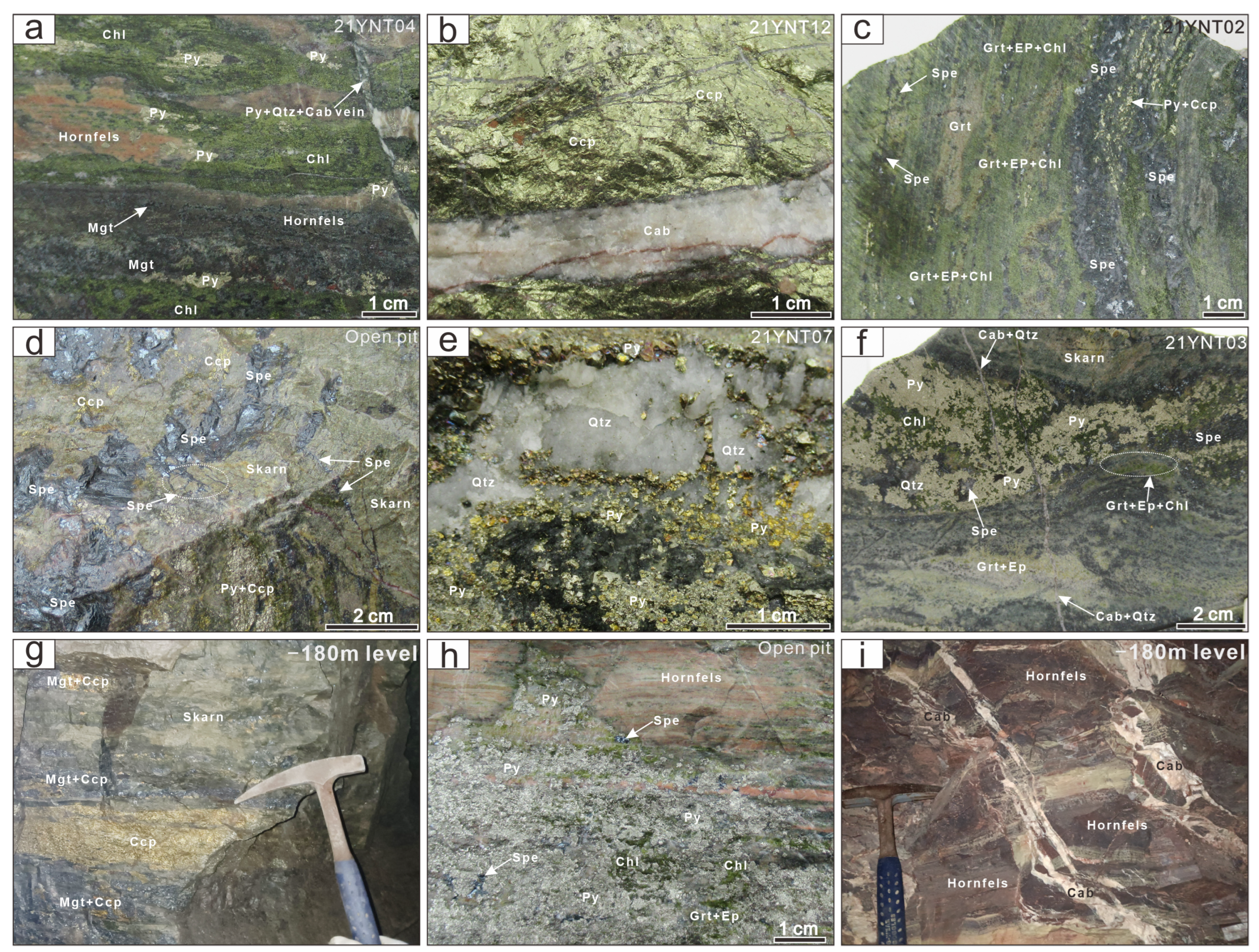
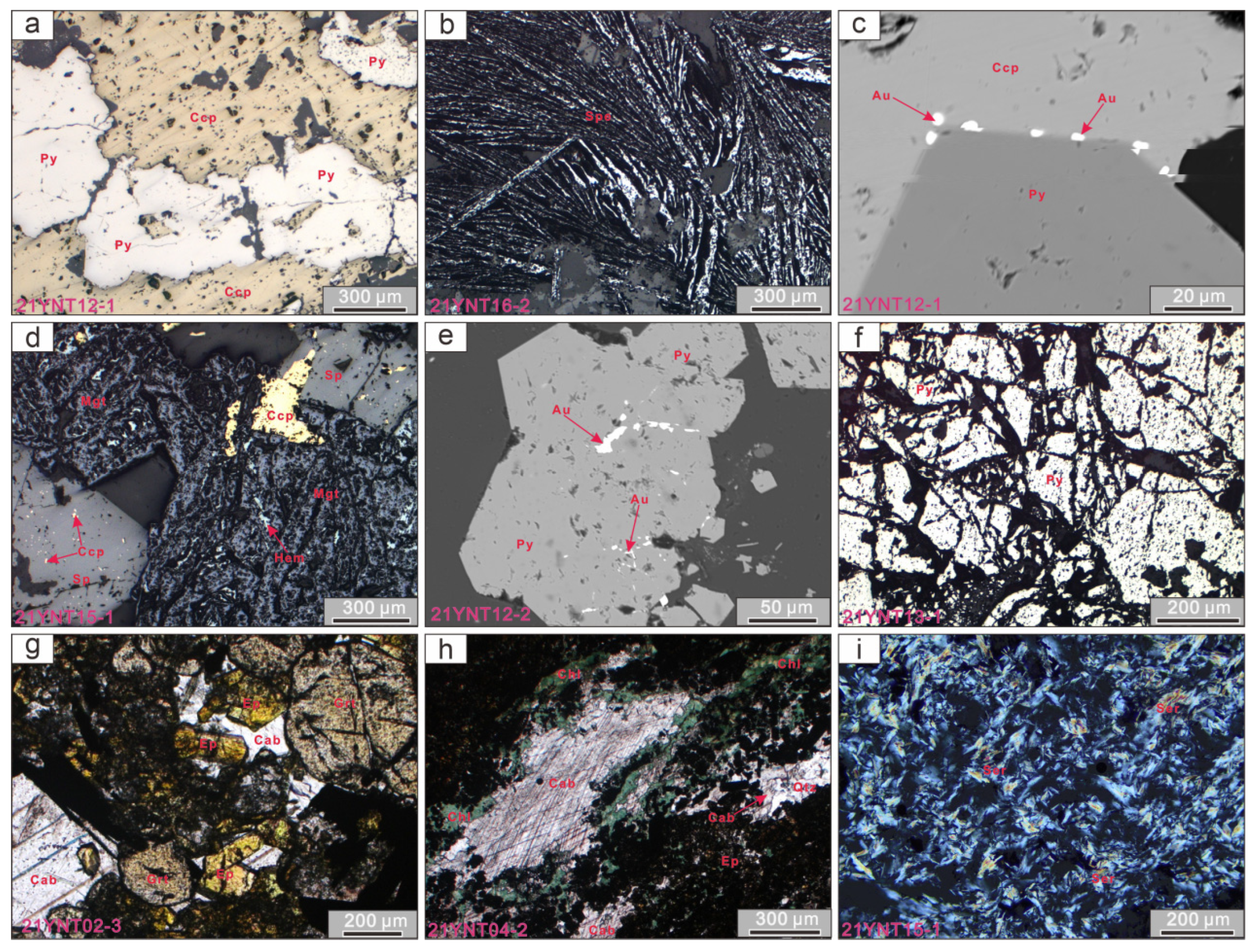
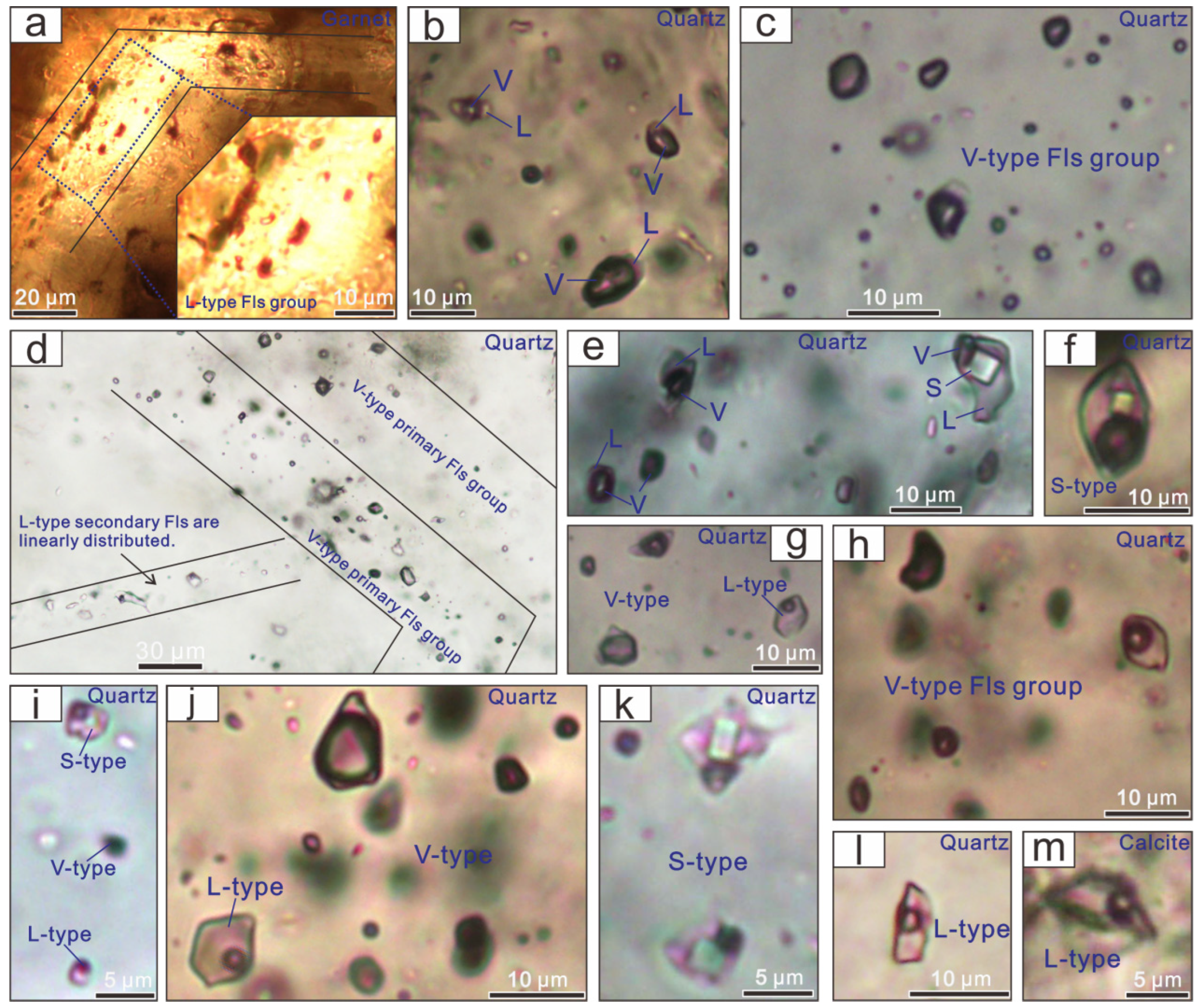
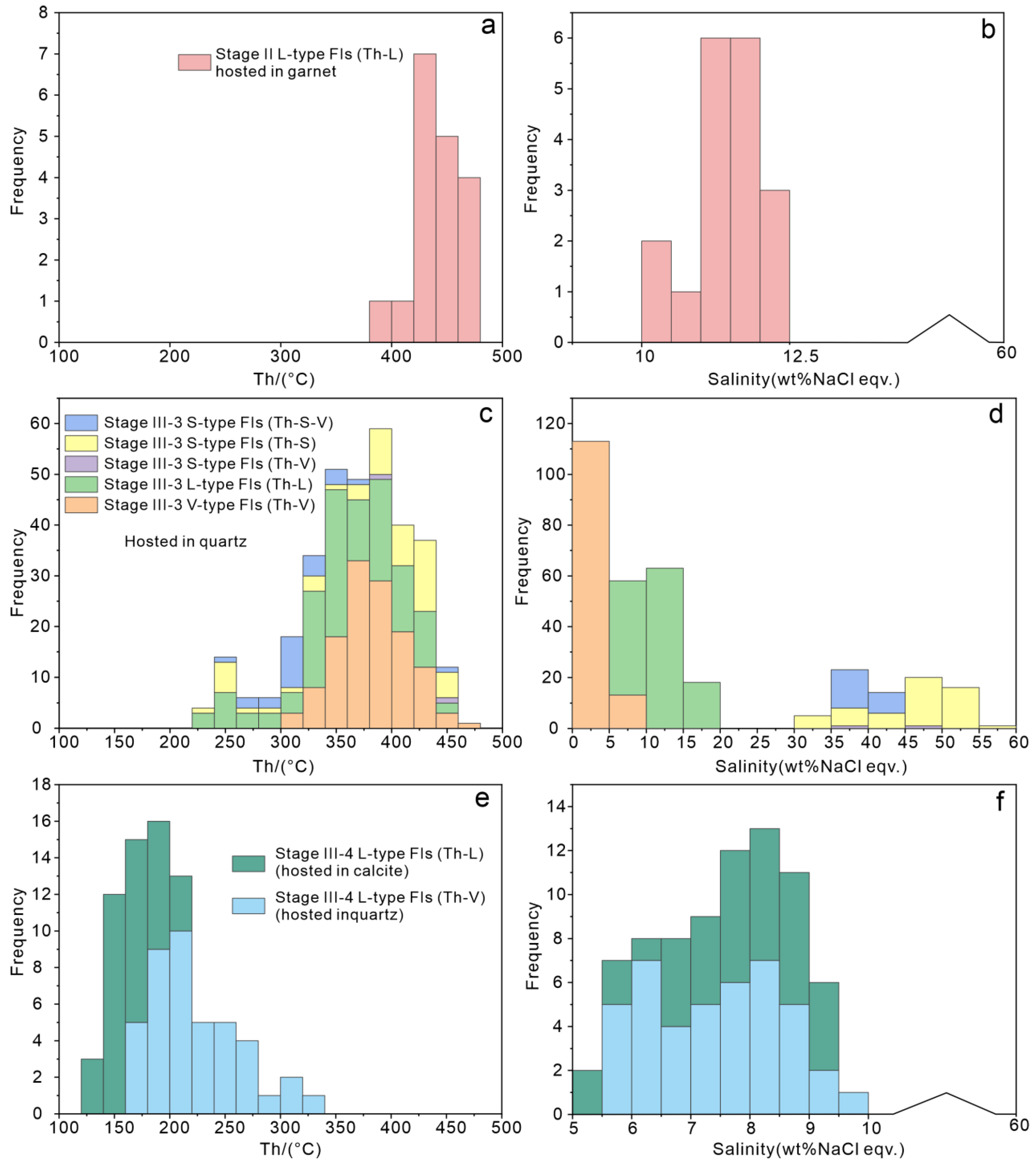
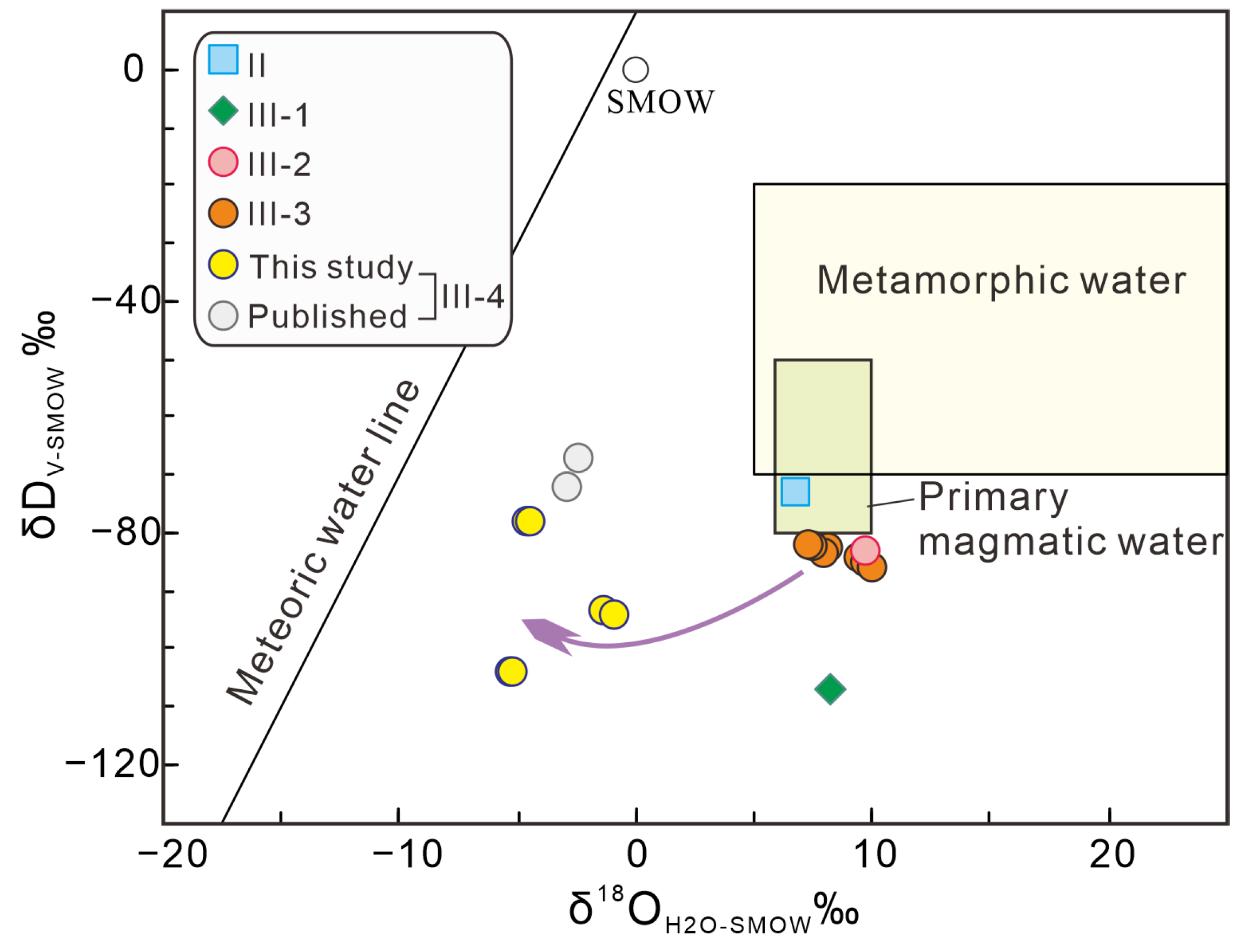
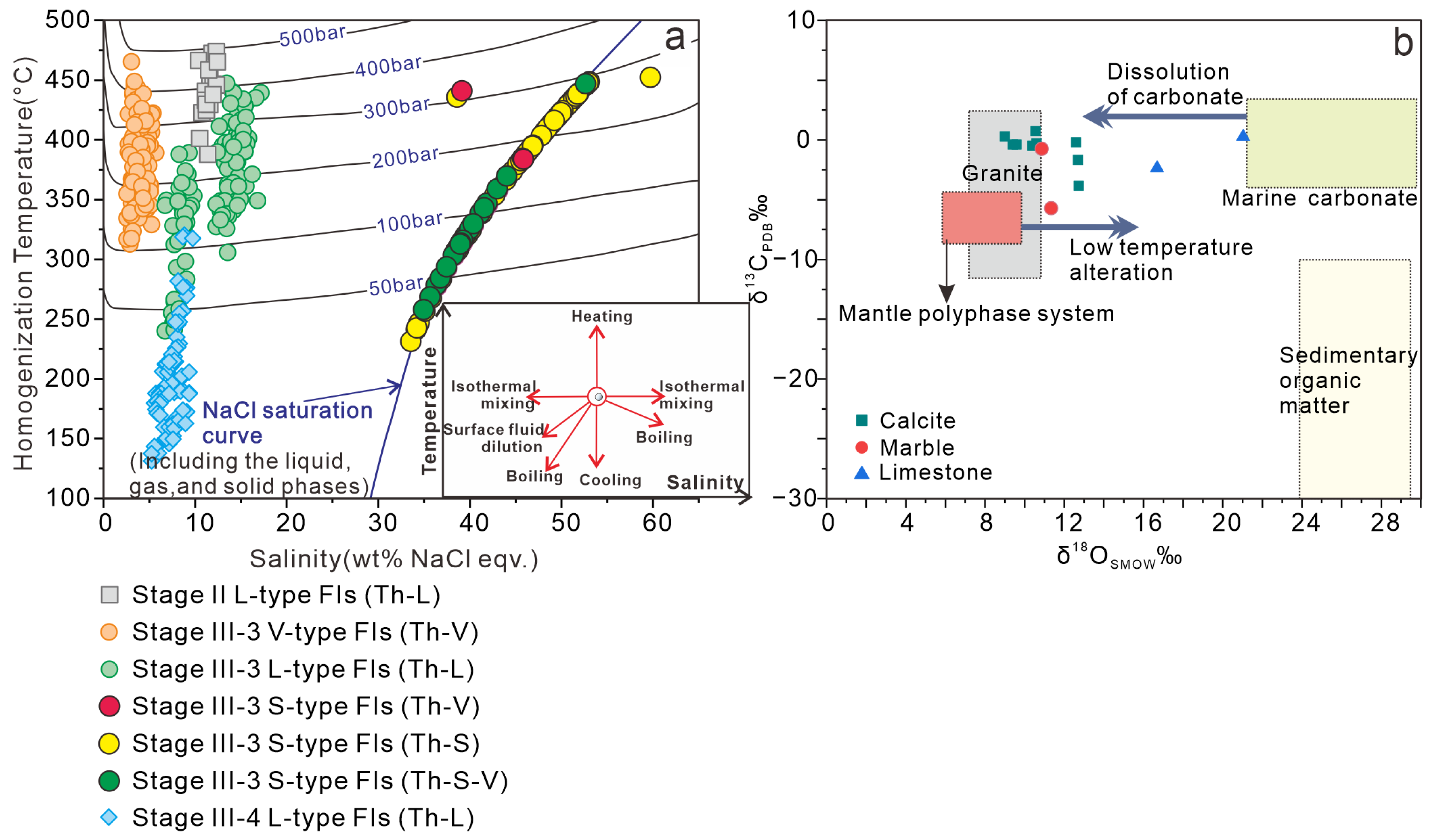
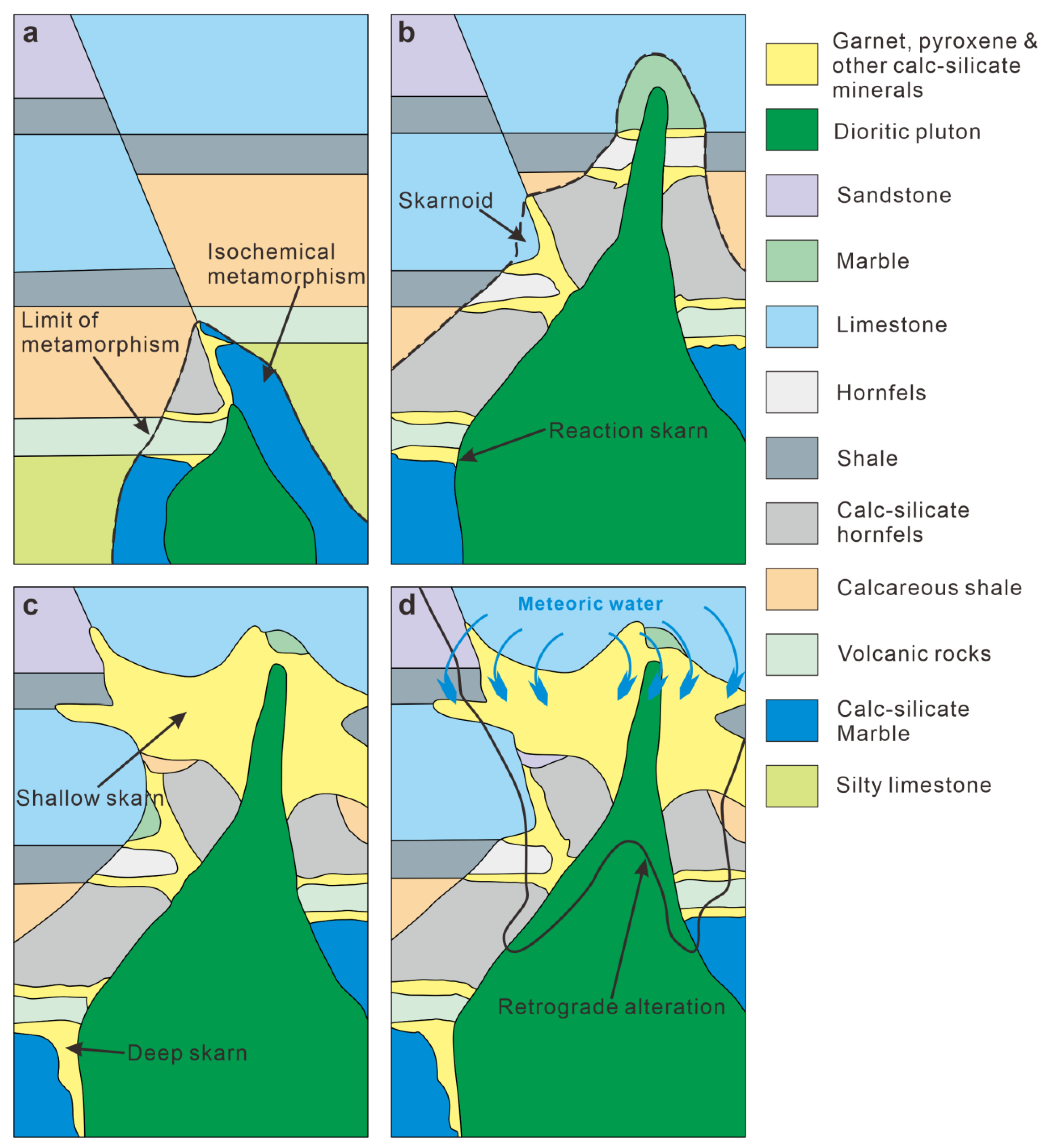
Disclaimer/Publisher’s Note: The statements, opinions and data contained in all publications are solely those of the individual author(s) and contributor(s) and not of MDPI and/or the editor(s). MDPI and/or the editor(s) disclaim responsibility for any injury to people or property resulting from any ideas, methods, instructions or products referred to in the content. |
© 2023 by the authors. Licensee MDPI, Basel, Switzerland. This article is an open access article distributed under the terms and conditions of the Creative Commons Attribution (CC BY) license (https://creativecommons.org/licenses/by/4.0/).
Share and Cite
Cai, W.; Liu, X.; Zhang, Z.; Gao, J.; Lei, M.; Cui, Q.; Ma, M.; Li, Y.; Song, Y. Genesis of the Yi’nan Tongjing Gold–Copper Skarn Deposit, Luxi District, North China Craton: Evidence from Fluid Inclusions and H–O Isotopes. Minerals 2023, 13, 1348. https://doi.org/10.3390/min13101348
Cai W, Liu X, Zhang Z, Gao J, Lei M, Cui Q, Ma M, Li Y, Song Y. Genesis of the Yi’nan Tongjing Gold–Copper Skarn Deposit, Luxi District, North China Craton: Evidence from Fluid Inclusions and H–O Isotopes. Minerals. 2023; 13(10):1348. https://doi.org/10.3390/min13101348
Chicago/Turabian StyleCai, Wenyan, Xiao Liu, Zhaolu Zhang, Jilei Gao, Ming Lei, Qingyi Cui, Ming Ma, Yadong Li, and Yingxin Song. 2023. "Genesis of the Yi’nan Tongjing Gold–Copper Skarn Deposit, Luxi District, North China Craton: Evidence from Fluid Inclusions and H–O Isotopes" Minerals 13, no. 10: 1348. https://doi.org/10.3390/min13101348
APA StyleCai, W., Liu, X., Zhang, Z., Gao, J., Lei, M., Cui, Q., Ma, M., Li, Y., & Song, Y. (2023). Genesis of the Yi’nan Tongjing Gold–Copper Skarn Deposit, Luxi District, North China Craton: Evidence from Fluid Inclusions and H–O Isotopes. Minerals, 13(10), 1348. https://doi.org/10.3390/min13101348




